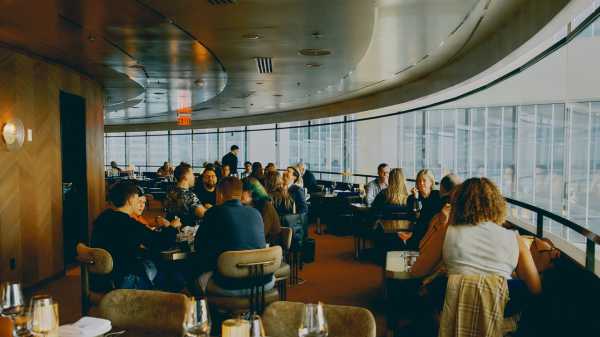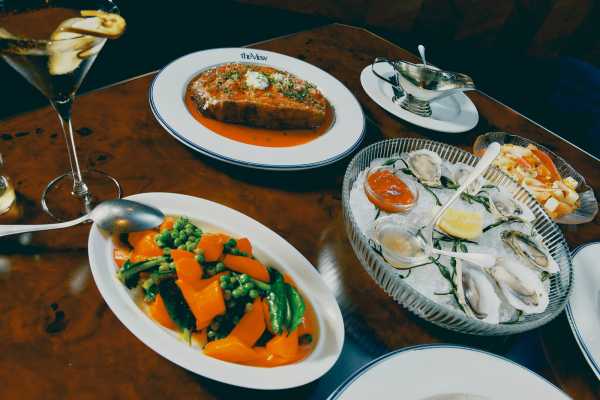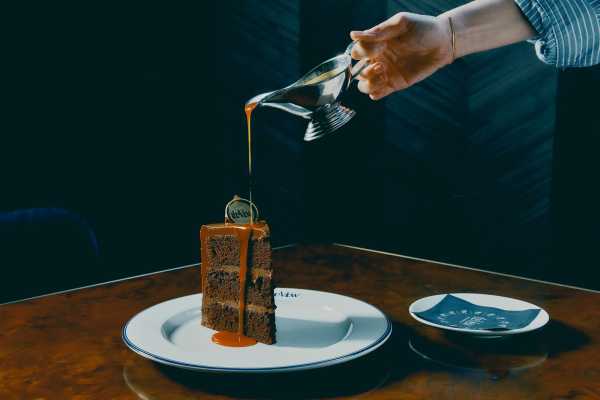
Save this storySave this storySave this storySave this storyYou’re reading the Food Scene newsletter, Helen Rosner’s guide to what, where, and how to eat. Sign up to receive it in your inbox.
Seeing New York City from above—from the upper deck of the Empire State Building, or from the window of an airplane making an up-the-Hudson approach to LaGuardia Airport—is always a disorienting rush. There are the vast arcs of the avenues, the great green slashes of parks and cemeteries, the jagged field of skyscrapers, steepled and spiked like iron filings pulled up toward the great magnet of the sky. On the ground, too, the city is a spectacle: sit on any stoop, or at any sidewalk café, and take in the sounds of man and machine, the polychromatics of the auto garages and the shoppy shops, the endless side scroll of cars and foot traffic. It’s a twenty-four-hour show whose run never closes. The View, a newly opened restaurant taking over the top of the New York Marriott Marquis, a concrete hulk of a hotel in Times Square, belongs to neither stratum. In the decades since the hotel opened, in 1985, new structures have risen around and above it. Today, the view from the View is mostly of office towers and hotels. You look out of the windows and see other windows, eye to eye.
But, wait, it revolves! Set inside a vast glass-encased aerie, the restaurant comprises two stories—a lounge above and a dining room below—each resting atop an enormous rotating platform, whose mechanisms are effectively the same as those of train-yard turntables. Few touristy gimmicks are more touristy or more gimmicky than a spinning restaurant, which efficiently combines observation-deck gawking with the mundane necessity of eating dinner. The View opened in February, reinvigorating a space that had sat empty for a few years. Before that, it contained a buffet-based situation that catered to a stupendous volume of customers and had no culinary or cultural impact on the city whatsoever. (It closed in the early months of the pandemic.) Now, operated by the famed restaurateur Danny Meyer’s Union Square Hospitality Group, the View is making a bid for something beyond travel-guidebook oblivion. It is a touristy restaurant that isn’t a tourist trap—a place that even the most jaded local might actually want to swing by (swing up to?) for a pre-theatre drink or a special-occasion meal.

Cocktails are served in the lounge, a floor above the dining room.
The tourist in New York City faces dining needs that may or may not align with those of the local population. Where to eat lunch before a weekend matinée at Lincoln Center? Brunch on a Tuesday? A wee-hours half-meal to prevent a pleasant buzz from levelling up to the spins? If you really want to live like a local, the answer to all three might be scarfing leftover couscous straight out of Tupperware, in your apartment, in your underwear. It’s left to the out-of-towners to breathe the real-New York air at Café Fiorello, Breakfast by Salt’s Cure, and Prince St. Pizza—places that aren’t necessarily very good, but which specialize in what the academic and social theorist Dean MacCannell, in his seminal 1976 work on tourism as a social phenomenon, called “staged authenticity.”
There are a few clues—besides the big, shticky, rotating one—that the View might be another such restaurant. The menu has instances of “New York” theming, with cocktails inspired by Magnolia Bakery’s banana pudding and the pastrami sandwich at Katz’s Deli. The background music, pleasantly tinkled nightly by a real person sitting at a real piano, mixes in pop melodies alongside the Broadway classics and jazz standards. But there are also a few tells that the View is a place catering to locals—or, at least, a place where locals might not have their anti-touristic allergies triggered. The muted, elegant interiors, for instance, are designed by David Rockwell, whose burgundies and golds evoke the dramatics of the theatre district without overtly caricaturing it. The wine list is strikingly good and (also strikingly) not terribly expensive. The establishment’s subtle sense of dual purpose is something of a Danny Meyer signature. In 2005, when he opened the Modern, a fine-dining restaurant inside the then newly renovated Museum of Modern Art, one of the most notable details was that it had its own street entrance, which allowed patrons to come in for dinner without the touristy indignity of patronizing the museum.

A salad made with citrus and hearts of palm.
No matter where you call home, entering the View is a laborious affair. Once you’ve escaped the rugby-like scrum of Times Square for the hotel lobby, you’ll navigate a confusing tangle of entrances, escalators, lobbies, and sub-lobbies. At last, a glass-walled elevator to the restaurant will shoot you upward at thrill-ride speed, hurtling through the hotel’s vertiginous atrium, past the open-plan gym and seemingly endless hotel-room floors, before opening onto the smiling faces of hosts behind a reception desk. (The effect is somehow even more jarring in reverse: the labyrinthine null-space of the hotel’s downstairs lobbies tarnishes the pleasures of the restaurant in precisely the same way that waiting in the passport-control line at J.F.K. kills the beta-blocking effects of a beachside vacation.)
The movement of the restaurant is subtle, and only very marginally vertigo-inducing. According to the View’s official metrics, the upstairs lounge takes forty-five minutes to complete a rotation, and the dining room takes an hour and a half. By my own calculations, things move a bit more leisurely, and if you’re not paying attention to landmarks out the window you might forget that you’re moving entirely—though you might, as I did, get completely disoriented both searching for and returning from the restroom, which is housed in a nonrotating central column that also contains the kitchen. Marjorie Meek-Bradley, the executive chef, previously consulted on the opening menu at the Corner Store, the impenetrably trendy SoHo restaurant that I might describe as a celebrity Applebee’s. At the View, she similarly specializes in American comfort food, this time of a retro, ritzified sort—an approach that feels philosophically correct for what the View is trying to do, and for the various categories of diner to whom it’s trying to speak. There’s a burger and several steaks, a shrimp cocktail and a tuna carpaccio, a Waldorf-ish salad and potatoes au gratin. Certain dishes are stronger than others. You might observe your companion’s luscious crab-cake appetizer, golden and plump, positioned just so on a circle of rémoulade sauce, and regret your comparatively blah Caesar salad. You might order the Katz’s Martini (with brisket-washed gin and a pastrami-spiced rim, though you can’t really taste either) and wish you’d instead had the vivacious Shirley Temple, made with a proprietary grenadine that has a surprisingly sophisticated, fruity depth. (Ask for a shot of vodka if you must.)

The retro-American menu includes a side dish of peas and carrots.
Generally speaking, though, even the most obvious or simple dishes feel as though they have been made with impressive consideration. The signature dessert, a towering slice of night-dark chocolate cake, is drizzled tableside with an entirely unnecessary salted caramel, but it’s delicious nonetheless. The cherries jubilee, an Escoffier classic that seems to be on the edge of a well-deserved comeback, are, tragically, flambéed offstage, in the kitchen, for reasons a server indicated had to do with fire hazards, but it doesn’t fail to delight. The best dish I had, one I have since tried to re-create at home, is a side of peas and carrots that evokes frozen TV dinners but tastes flawlessly fresh: the vegetables cooked just to tenderness, and glazed silkily in butter, with tendrils of pea shoots adding a layer of floral green to all the starchy garden sweetness.

A slice of chocolate cake.
During a recent phone conversation, Meyer told me that, when Marriott first approached him about taking over the odd, dated, uncool space, he thought it was “insane,” and knew instantly that he had to do it. As a teen-ager, in St. Louis, he’d had a formatively terrible experience visiting a rotating restaurant on top of the now closed Stouffer’s Riverfront Inn. “You didn’t need to go more than once, because it wasn’t very good,” he said. The food was bad, the service lacklustre, and even the view failed to deliver, with the drama of the nearby Gateway Arch undermined by the charmless vistas of East St. Louis. There are at least seventeen currently operational rotating restaurants in the United States, the closest being the Skydome Restaurant in Arlington, Virginia, but the disappointing memory of Stouffer’s was Meyer’s only benchmark. “I said, ‘I bet we can do better,’ and I think we did.”
Dining on the move.
That might sound like a low bar to clear, but part of the fun of the View lies in how handily it transcends its teetering proximity to both kitsch and terribleness. The restaurant, by the way, is not Union Square Hospitality Group’s only establishment atop a skyscraper. Manhatta, open since 2018, is situated on the sixtieth floor of a building in the financial district. There, again, the name and location signal “tourist trap,” but the experience delivers something different. Somehow, despite the formidable verticality of its elevator ride, Manhatta has become a viable date-night spot, or a place to grab (admittedly fancy) after-work drinks. In subtle, intentional ways—through the aesthetic austerity of its interior, and the cheffy ambition of its menu—the restaurant communicates that the view out the window belongs to you. It’s a perch from which to take in the sights of your own city, rather than to marvel at a city you’ve come to see.
Helen, Help Me!
E-mail your questions about dining, eating, and anything food-related, and Helen may respond in a future newsletter.
The View, burdened as it is by its chaotic location and its horrible entrance, and by the absurdity of its slow gyration, is unlikely to shed its touristic vibes quite so easily (or at all). It exists today only because it seemed glamorous, in 1985, to put an engineering novelty at the top of a newly built hotel, and it would now be next to impossible to remove it. But there’s something interesting there: something about the durability of what we build, the hubris of trend-driven architecture, the virtues of nimble adaptation. You make the most of what you’ve got. You look out the windows, and if you don’t like what you see, don’t worry. The promise of the revolving restaurant is that, soon enough, something better is certain to come into view. ♦
Sourse: newyorker.com







